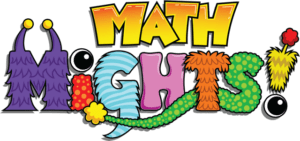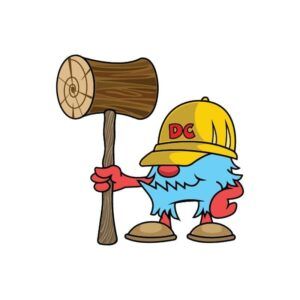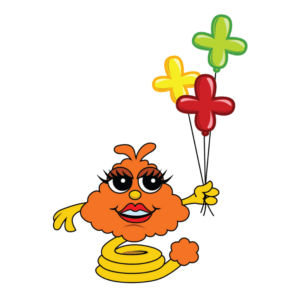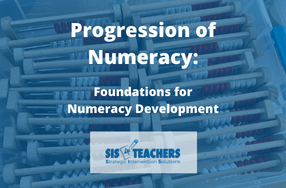In case you’ve missed it, we’re a *little* excited about our Math Mights show that launched last week! Two new shows from every grade level (K-3) per week – it’s incredible!
 Don’t let the cute, colorful cartoon characters fool you! There is a lot of careful thought and planning that goes into the development of each show! We purposefully incorporate the 8 Mathematical Practices, and each show is tied to specific standards that you’re teaching in your classroom (maybe even this week!). We based the lessons on IM K–5 Math™, an openly-licensed curriculum authored by Illustrative Mathematics, one of my favorite resources, and were able to use a beta version of their program, which is coming out in July. Many of the aspects of their program complement and support what we do at SIS4Teachers.
Don’t let the cute, colorful cartoon characters fool you! There is a lot of careful thought and planning that goes into the development of each show! We purposefully incorporate the 8 Mathematical Practices, and each show is tied to specific standards that you’re teaching in your classroom (maybe even this week!). We based the lessons on IM K–5 Math™, an openly-licensed curriculum authored by Illustrative Mathematics, one of my favorite resources, and were able to use a beta version of their program, which is coming out in July. Many of the aspects of their program complement and support what we do at SIS4Teachers.
Check out all the details and supporting resources at mathmights.org.
 Additionally, we want to help you understand the pedagogy behind the shows so you can better incorporate them into what you’re teaching. Just like with our students, we want you to understand the WHY behind the HOW of each episode. So, each week, we’ll bring you into our planning process a little bit, help you learn what each show is about, what strategies we use and why, and even what manipulatives we choose and why.
Additionally, we want to help you understand the pedagogy behind the shows so you can better incorporate them into what you’re teaching. Just like with our students, we want you to understand the WHY behind the HOW of each episode. So, each week, we’ll bring you into our planning process a little bit, help you learn what each show is about, what strategies we use and why, and even what manipulatives we choose and why.
Basically, these are your teacher notes so you can get the most out of the Math Mights Shows!
Teacher's Guide
Episodes 213-214
For the month of January, the number/numeracy talks are the key! We hope you use them to really provide an opportunity for engagement for your students! USE THEM IN YOUR CLASSROOM! Show the video, let the teacher on the screen do your numeracy talk that day, and just pause it where you want your students to stop and talk, then resume – it’s that easy regardless of your teaching format!
Kindergarten
 Focus: 213: Addition Word Problems / 214: Subtraction Word Problems
“I Can” statement: I can use objects or drawings to show addition/subtraction problems.
Extension Activity: math work mats and quantitative pictures.
The beginning part of the Kindergarten show really focuses on a number talk review or a numeracy review with conservation to 10 to see if we can tell how many without counting.
If you’re not familiar with our number talks and our numeracy talks in the lower elementary, we have some really great resources that will really help.
In these episodes, we’re working in the 10-frame, getting the idea of flashing numbers, the idea of subitizing, and helping kids get into the character of Dotson, the Subitizing Superhero from the Deck o’ Dots cards. The show gives different kids’ thought processes, and we’ve already heard from people that have used the number talks in their classrooms that their students were relating to the kids on the show and how they thought of solving the problems!
After the warm up, we have an engagement, where all kids have access to the lesson. We ask open-ended questions such as – Which one doesn’t belong? What do you wonder? What do you notice? The goal is to get kids to engage with the objective without really knowing it, which is similar to what I usually call a Lesson Launch. With word problems, we want kids to have the imagery in their heads, to be able to close their eyes and imagine the story – “On a warm, sunny afternoon, I saw two red birds in the tree and three blue birds join them.” We want to give kids a picture of what those birds look like, which will help when they’re acting out the problem.
Of course, the kids know that we can’t actually go grab real birds and put them on their Math Work Mat to act out the story, but we can use counters, or anything that you might have in your house or at school, to represent those birds in that problem. During this part of the lesson, students are using auditory understanding as they hear the word problem, and then act it out.
Focus: 213: Addition Word Problems / 214: Subtraction Word Problems
“I Can” statement: I can use objects or drawings to show addition/subtraction problems.
Extension Activity: math work mats and quantitative pictures.
The beginning part of the Kindergarten show really focuses on a number talk review or a numeracy review with conservation to 10 to see if we can tell how many without counting.
If you’re not familiar with our number talks and our numeracy talks in the lower elementary, we have some really great resources that will really help.
In these episodes, we’re working in the 10-frame, getting the idea of flashing numbers, the idea of subitizing, and helping kids get into the character of Dotson, the Subitizing Superhero from the Deck o’ Dots cards. The show gives different kids’ thought processes, and we’ve already heard from people that have used the number talks in their classrooms that their students were relating to the kids on the show and how they thought of solving the problems!
After the warm up, we have an engagement, where all kids have access to the lesson. We ask open-ended questions such as – Which one doesn’t belong? What do you wonder? What do you notice? The goal is to get kids to engage with the objective without really knowing it, which is similar to what I usually call a Lesson Launch. With word problems, we want kids to have the imagery in their heads, to be able to close their eyes and imagine the story – “On a warm, sunny afternoon, I saw two red birds in the tree and three blue birds join them.” We want to give kids a picture of what those birds look like, which will help when they’re acting out the problem.
Of course, the kids know that we can’t actually go grab real birds and put them on their Math Work Mat to act out the story, but we can use counters, or anything that you might have in your house or at school, to represent those birds in that problem. During this part of the lesson, students are using auditory understanding as they hear the word problem, and then act it out.
 I think it is really important for kids to do where a story doesn’t just end as soon as you say it, but that a story can continue and that you can continue acting it out on a mat. In Episode 214, Mrs. Gray does a great job with using a forest mat and having different animals come to and leave the forest, which helps kids apply the beginning parts of addition and subtraction.
At this level, we’re not necessarily focused on kids writing an equation yet. We just want them to get an idea of what’s happening in the story. Approaching word problems like this is developmentally appropriate for Kindergarteners, as well as preschoolers.
We have more on using math work mats in our SIS4Students series, Week 3: Real Life Math, which you might find helpful!
I think it is really important for kids to do where a story doesn’t just end as soon as you say it, but that a story can continue and that you can continue acting it out on a mat. In Episode 214, Mrs. Gray does a great job with using a forest mat and having different animals come to and leave the forest, which helps kids apply the beginning parts of addition and subtraction.
At this level, we’re not necessarily focused on kids writing an equation yet. We just want them to get an idea of what’s happening in the story. Approaching word problems like this is developmentally appropriate for Kindergarteners, as well as preschoolers.
We have more on using math work mats in our SIS4Students series, Week 3: Real Life Math, which you might find helpful!
 Another helpful resource is the Math Talk book, which we reference for quantitative pictures, or pictures with plenty of action and objects that provide opportunities for students to create and engage in a story problem.
Another helpful resource is the Math Talk book, which we reference for quantitative pictures, or pictures with plenty of action and objects that provide opportunities for students to create and engage in a story problem. First Grade
 Focus: 213: Identifying 10s and 1s: Part 1 / 214: Identifying 10s and 1s: Part 2
“I Can” statement: I can tell how many 10s and 1s are in a number.
Extension Activities: Place Value Concentration with Value Pak, Value Pak practice pages
In these shows, we’re really working on identifying 10s and 1s on two different levels. At the beginning of the first grade number talks, we’re starting off with our numeracy talks in the double 10-frame. Eventually, we’ll work into actual number talks. Here, we do a lot of subitizing with Dotson the Subitizing Superhero. We want the kids to tell how many they see and why, but we also want them to realize that there’s more than one reason why. It’s not 16 just because you saw a 10 at the top and a 6 of the bottom, but another student noticed that there were 4 empty in the double 10-frame, or another student saw it as 5, 5, 5 and 1.
Focus: 213: Identifying 10s and 1s: Part 1 / 214: Identifying 10s and 1s: Part 2
“I Can” statement: I can tell how many 10s and 1s are in a number.
Extension Activities: Place Value Concentration with Value Pak, Value Pak practice pages
In these shows, we’re really working on identifying 10s and 1s on two different levels. At the beginning of the first grade number talks, we’re starting off with our numeracy talks in the double 10-frame. Eventually, we’ll work into actual number talks. Here, we do a lot of subitizing with Dotson the Subitizing Superhero. We want the kids to tell how many they see and why, but we also want them to realize that there’s more than one reason why. It’s not 16 just because you saw a 10 at the top and a 6 of the bottom, but another student noticed that there were 4 empty in the double 10-frame, or another student saw it as 5, 5, 5 and 1.
 We really focus on the 8 Mathematical Practices here, especially Practice 3 – getting kids to construct viable arguments and critique the reasoning of others. In the “I Can” statements of these shows, we really try to use that philosophy to help kids understand why 10s and 1s are so important. We start with a collection of base 10 blocks or a spill of unifix cubes and present the students with questions to get them to arrive at the objective on their own. We let them do the thinking! How are we going to count all these things? What do you notice? What do you wonder? Some kids might say we can count by 2s or 5s, but is that the most efficient way? Eventually, we want them to understand why grouping things in 10s is really important.
I think one of the biggest things that we stress in these shows is that there isn’t just one modality – you don’t just have to use unifix cubes! Bring in your 10-frame because kids are already familiar with that structure. Use the abacus, one of my favorite tools, to help students see our number system in 10s and 1s. And, of course, the Value Pak, which wears their values on their bellies.
We really focus on the 8 Mathematical Practices here, especially Practice 3 – getting kids to construct viable arguments and critique the reasoning of others. In the “I Can” statements of these shows, we really try to use that philosophy to help kids understand why 10s and 1s are so important. We start with a collection of base 10 blocks or a spill of unifix cubes and present the students with questions to get them to arrive at the objective on their own. We let them do the thinking! How are we going to count all these things? What do you notice? What do you wonder? Some kids might say we can count by 2s or 5s, but is that the most efficient way? Eventually, we want them to understand why grouping things in 10s is really important.
I think one of the biggest things that we stress in these shows is that there isn’t just one modality – you don’t just have to use unifix cubes! Bring in your 10-frame because kids are already familiar with that structure. Use the abacus, one of my favorite tools, to help students see our number system in 10s and 1s. And, of course, the Value Pak, which wears their values on their bellies.
Second Grade

Focus: 213 – Subtracting on a Numberline / 214 – Open Numberline
“I Can” statement: I can subtract with a number line.
Extension Activity: Springling practice pages
 This is my show! I start with actual number talks reviewing the idea of being able to mentally add a two digit and a single digit number, using our friend D.C. I want kids to try this mental strategy! Pause it and see if your kids can come up with the ways of solving that we did! What’s important here is getting kids to talk about their mental strategies and show that, while we might have the same strategy, you might have a different way of going about it.
This is my show! I start with actual number talks reviewing the idea of being able to mentally add a two digit and a single digit number, using our friend D.C. I want kids to try this mental strategy! Pause it and see if your kids can come up with the ways of solving that we did! What’s important here is getting kids to talk about their mental strategies and show that, while we might have the same strategy, you might have a different way of going about it.
I will tell you I struggled in the idea of the way Illustrative Math uses a number line with actual numbers. As you know, I’m much more of an open number line person, but after some consideration, I decided to use the numbers on the number line at the beginning of the show as kids might be just becoming familiar with the idea of number lines. I wanted to have the numbers on the number line to get the idea of spacing between numbers, how to count up and count back and how to hop in friendly numbers and what our friendly numbers are.

In the second show, we stress the idea of the distance between two numbers. We take a string and show kids that subtraction really is not “take away,” but we’re looking at the distance between the two numbers to figure out what that difference is. Here, we use the open number line instead of the numbered number line because kids are able to start and stop that number line wherever they want to and I think that an important piece about subtraction. We also help kids relate to the character of Springling. Second graders love her! They really get into telling her to “Hop, Springling, Hop” as they’re able to visually see that distance by counting up or back.
Third Grade

Focus: 213 – “groups of” / 214: “fair shares”
“I Can” statement: I can understand multiplication by thinking about groups of objects.
I can understand division by thinking about how one group can be divided into smaller groups.
Extension Activities: Multiplication Tetris, Division Bump (student-approved math games!)
I feel like we can never spend too much time reviewing multiplication and division concepts. In these episodes, we give a light introduction to multiplication and division to help you see where we’re going in future shows later on in the season.
 We do start these episodes off with a number talk focusing on subtraction and reviewing the ideas of Springling. We’re doing a lot with addition and subtraction review and the number talks, as we’re learning multiplication and division. I think it’s okay to not have multiplication/division number talks when you’re just learning about it. Let kids keep their addition and subtraction skills sharp through review and see if they can construct viable arguments and critique the reasoning of others.
We do start these episodes off with a number talk focusing on subtraction and reviewing the ideas of Springling. We’re doing a lot with addition and subtraction review and the number talks, as we’re learning multiplication and division. I think it’s okay to not have multiplication/division number talks when you’re just learning about it. Let kids keep their addition and subtraction skills sharp through review and see if they can construct viable arguments and critique the reasoning of others.
 Language is a big focus in these episodes. What does the “x” mean in a multiplication problem? It’s not “times” but “groups of.” We can show four groups of three, but how would that look different if I showed three groups of four? We spend a lot of time with this concept and using the place value discs as a really valuable tool. You can use the virtual manipulative, or download the pdf and print/cut them out to use physically.
Language is a big focus in these episodes. What does the “x” mean in a multiplication problem? It’s not “times” but “groups of.” We can show four groups of three, but how would that look different if I showed three groups of four? We spend a lot of time with this concept and using the place value discs as a really valuable tool. You can use the virtual manipulative, or download the pdf and print/cut them out to use physically.
 Then we spend good time on the concepts of division. What is a dividend? What’s a divisor? What’s a quotient? We want kids to be able to use the language and be able to act out the problem in a step-by-step process with place value discs so they understand the concept behind what we’re doing.
Then we spend good time on the concepts of division. What is a dividend? What’s a divisor? What’s a quotient? We want kids to be able to use the language and be able to act out the problem in a step-by-step process with place value discs so they understand the concept behind what we’re doing.
Membership Bonus!
If you are a part of our M3 Molding Math Mindsets Membership, start yourself some folders and download the PowerPoints! You have access to ALL the teaching materials and animations that go with these lessons!
(valid M³ Membership login required)



